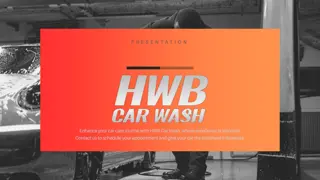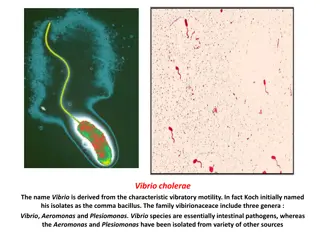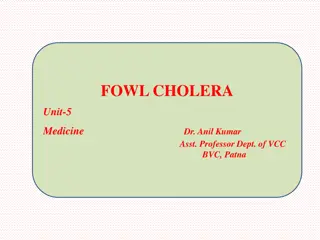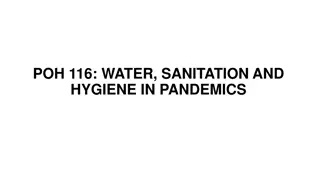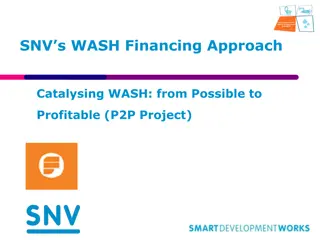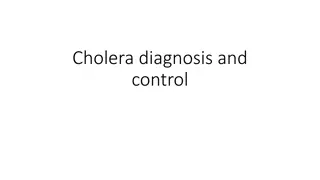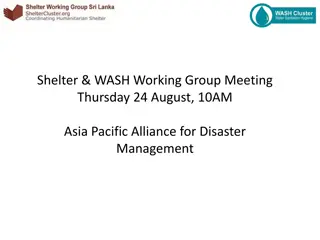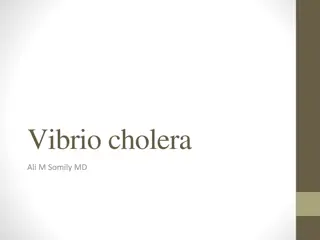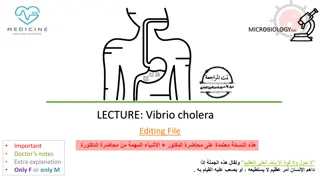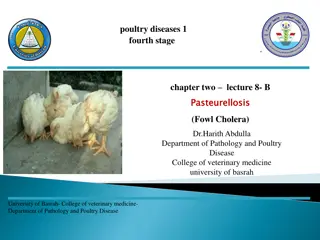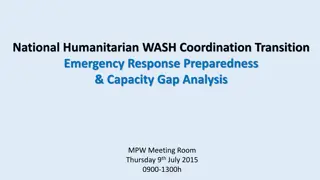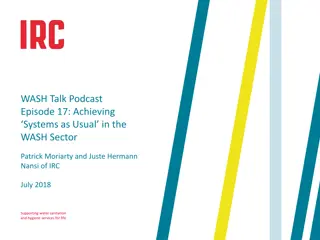A Look Into Cholera Control and WASH Services Worldwide
The World Health Organization, along with the Global Task Force for Cholera Control, is focusing on analyzing reported cholera cases from 2010-2021 and the levels of water, sanitation, and hygiene (WASH) services in various countries. The report highlights the importance of basic WASH services in preventing cholera outbreaks and identifies countries with low service levels most affected by the disease. The document also outlines key elements from the global roadmap for cholera control, emphasizing surveillance, case management, prevention strategies, and resource support. Furthermore, it stresses the crucial link between emergency responses and long-term development in addressing cholera outbreaks effectively.
Download Presentation

Please find below an Image/Link to download the presentation.
The content on the website is provided AS IS for your information and personal use only. It may not be sold, licensed, or shared on other websites without obtaining consent from the author. Download presentation by click this link. If you encounter any issues during the download, it is possible that the publisher has removed the file from their server.
E N D
Presentation Transcript
World Health Organization, Global Task Force for Cholera Control, IRC WASH Looking Ahead on WASH & Health: Where Do We Go From Here Connect-Health Programme
Background information: reported cholera cases (2010-2021) and WASH services levels Analysis of 4,970,328 cholera cases reported over the period 2010-2021 and WASH services in 234 countries and territories (JMP 2015): 98.0% of all reported cases are from countries (39) with basic+ water services lower than or equal to 80% and basic+ sanitation services lower than 65% 98.0% 96.7% of all cases reported come from 31 of the 34 countries with lowest water and sanitation combined service levels (basic+ water services less than 70% and basic+ sanitation services less than 55%) 96.7% Only 3 countries with less than 70% basic+ water service and less than 55% basic+ sanitation services do not report cholera cases over the period, including 2 islands (Madagascar and Salomon Island) Basic+: basic and safely managed services in JMP Water and Sanitation ladders Only 5 countries with more than 80% basic+ water and more than 60% basic+ sanitation reported significant number of cholera cases, with local transmissions (Dominican Republic, Iran, Iraq, Malaysia and Philippines)
2023 to date : 30 countries with cases/outbreak 2 cross-border outbreak spreads Largest outbreaks in years/decade Austral Africa Indian sub-continent Middle East Countries re-affected after years/decade Lebanon, South Africa
KEYELEMENTSFROMTHE GLOBAL ROADMAP EXAMPLESOF WASH AND HEALTH APPROACH SURVEILLANCE (epidemiological and environmental) and LABORATORY (case confirmation) CATI (Case Area Targeted Intervention ): Multisectoral approach (WASH, Health, RCCE, OCV) to cut Cholera transmission at outbreak early stage CASE MANAGEMENT, IPC AND WASH activities in outbreak response AXIS 1 Early detection and quick Response to contain outbreak Priority Areas for Multisectoral Interventions (PAMI): identification of hotspots with the integration of Epidemiological, WASH and Contextual indicators Bridging emergency and development: use the opportunity of field response (momentum) to start WASH surveys for middle to long term investments. Preventive Oral Cholera Vaccine (OCV) requests are related to WASH investment in the protocol. AXIS 2 A targeted prevention strategy in cholera hotspots AXIS 3 GTFCC Guidelines: Cholera Outbreaks (Case management), Environmental Surveillance Cholera Support Platform (CSP): technical and resource support at country level GTFCC support and coordination of human, technical and financial resources
BRIDGEBETWEENEMERGENCY & DEVELOPMENT Emergency Post-Emergency Development No or very little bridge for donors/actors between emergency and development. Stop the cycle that takes us from emergency to emergency. When there is a cholera outbreak, responders rush in soap and chlorine tablets, bring in safe water in trucks, and build temporary latrines to prevent the outbreak from spreading. While these actions are undoubtedly life-saving, longer-term investments in infrastructure can prevent outbreaks in the first place. Wherever in the world cholera has been eliminated, it has been thanks to improvements in safe water, basic sanitation and good hygiene practices access to which is an internationally recognized human right. Moving from an emergency response to long-term investments is more effective, because although cholera is a health issue, first and foremost, it s a development issue.
CHALLENGESINTHECHOLERARESPONSE Current situation (multiple outbreaks) do not give time for middle to long term implementation strategies Limited availability of OCV at global level Coordination between WASH and HEALTH is essential. Needs to promote more initiatives (WASH+, JART ) Programs and fundings are project oriented. Systemic approach must be implemented (especially budget) into country cycle within National Cholera Plans (NCP) Lack of evidence-based for innovation and strategies Cross-border spread of the disease Community engagement Bridge between emergency and development (actors, donors) Climate change (acute events, water resource availability)
All Systems Connect 2023 is made possible thanks to the generous support of our partners including the World Health Organization and :












